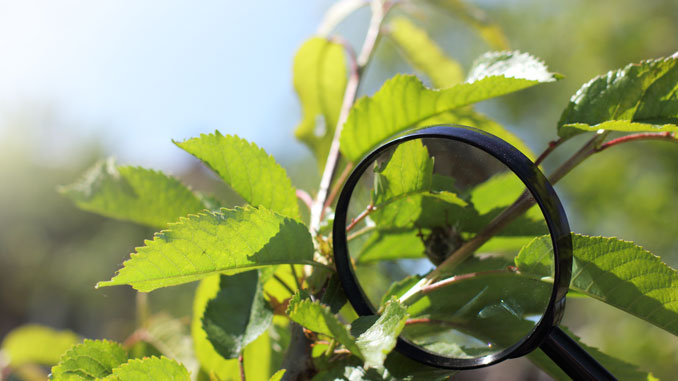
Few things are more frustrating to a gardener than watching a perfectly healthy plant begin to wilt, yellow, mold, spot, or get chewed on. Often times, if the perpetrator of these offenses is left for too long, the plant will need to be regularly treated. Fortunately, many garden pests can be healed with solutions completely harmless to pets and humans. We consulted with local garden expert and owner of In Season Nursery in Stockton, Julie Morehouse, on the most common garden pests, and how to treat them safely and effectively.
Mealy Bug A tiny white wingless bug that measures between a sixteenth and an eighth of an inch long. These little pests like to live in crevices where leaves overlap, and feed by using their long mouthparts to suck sap out of the plant’s tissue. This can cause the plant to experience yellow leaves, stunted growth, and die back. Solution: Spray them with a simple soap and water solution, then rinse with water. Follow-up treatments may be necessary. Be sure to check all your other plants as mealy bugs spread easily.
Scale This hard-shelled insect is particularly fond of citrus trees and other woody- stemmed plants where it remains in one place, feeding on sap, and secreting the excess. Scale has a mutualistic relationship with the ant, who happily harvests its sugary secretions. When the secretions are left on the plant, it can result in a black sooty mold growth. If not treated, this will eventually inhibit the plant’s ability to photosynthesize. Solution: Spray with a mixture of Neem oil, an organic pesticide that’s good for treating various pests and diseases, and water. You may have to treat with soap and water, as well, to minimize the mold.
Whitefly You know you have a white fly problem when brushing up on your plant results in little white flies fluttering everywhere. White flies like to live on the underside of plant leaves where they feed by sucking chlorophyll out of the plant. These little pests thrive in areas that are cool and moist, with poor air circulation. Solution: First, see if you can control the moisture issue by reducing watering. You can also treat them with Neem oil. Be sure to spray the underside of leaves.
Budworms are little green caterpillars that are commonly found on leafy green plants like petunias and geraniums. They live their entire life on the plant until they make a cocoon and fly away. If not treated, they will eat your flowers from the inside out. Solution: You can handpick them off when you see them, or they can be sprayed with a certified organic product called BT caterpillar killer. This product is harmless to humans and animals, and deadly to chewing insects like caterpillars.
Fungus Gnats are pesky little black flies that commonly show up when a plant’s soil has remained wet for too long. Although the adults may seem harmless, their larvae can really take a toll on your plant. Unlike their parents, who prefer to stay on the top layer of soil, fungus gnat larvae live deeper in the soil where they enjoy feasting on the tender roots of plants. This is often seen among houseplants, and can cause sudden wilting and yellowing of leaves. Solution: Let the soil dry out to at least a depth of 1 inch. You can also treat the soil with Neem oil and beneficial nematodes.
There are also a few common plant-damaging culprits that aren’t insects. Fungal diseases, such as black spot, powdery mildew, and rust fungi can wreak havoc on plants if not treated right away. Solution: Water in the morning so plants aren’t wet all night. Diseased leaves should be removed from the plant and surrounding area. Neem oil can also be used to treat these diseases.
Treat Your Plants
In Season Market and Nursery
215 E. Alpine Ave., Stockton
(209) 949-2499

